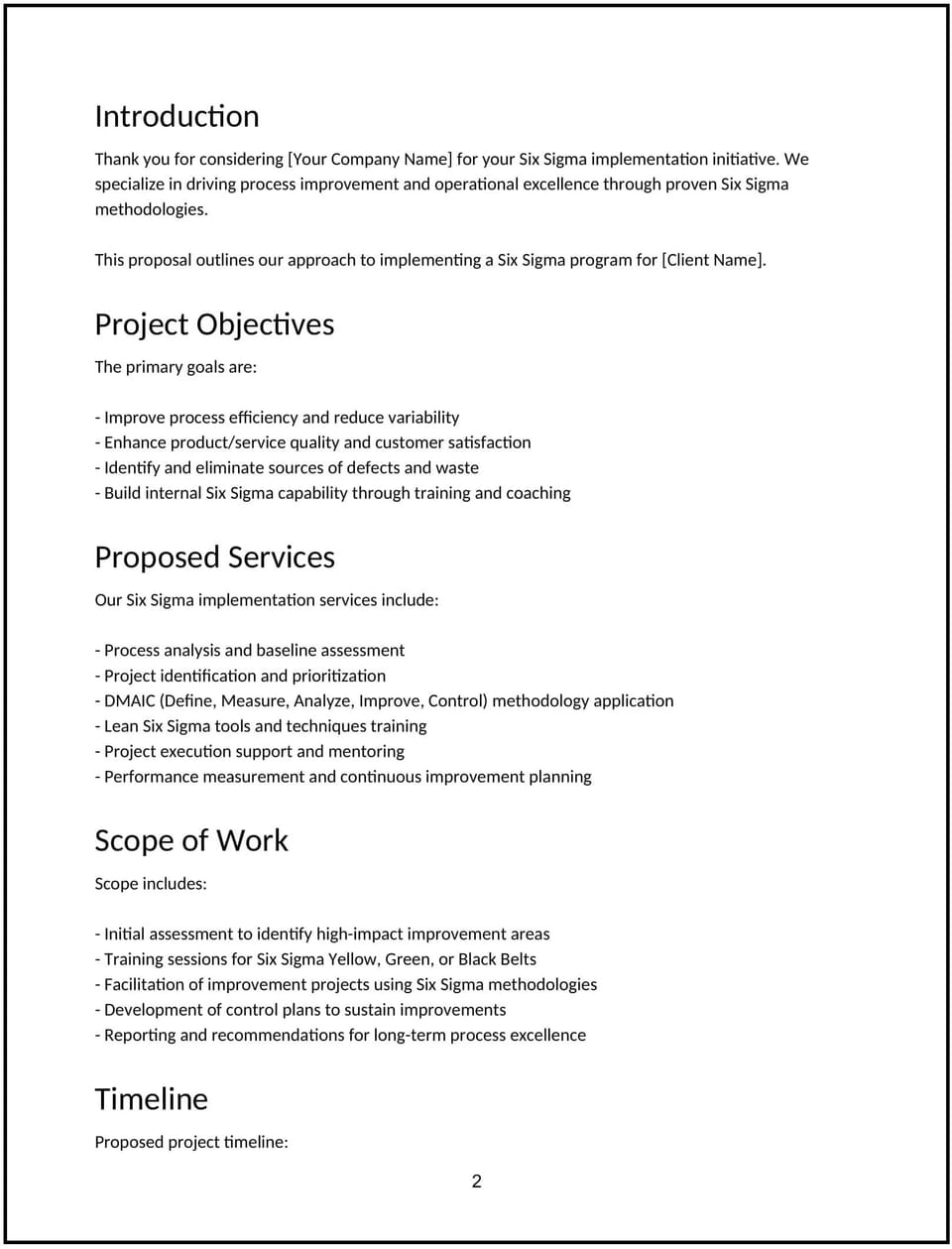Six Sigma implementation proposal: Free template

Customize this free Six Sigma implementation proposal with Cobrief
Open this free Six Sigma implementation proposal in Cobrief and start editing it instantly using AI. You can adjust the tone, structure, and content based on your client’s industry, operational maturity, and project goals. You can also use AI to review your draft — identify unclear phases, tighten the scope, and highlight improvement opportunities before sending.
Once you're done, send, download, or save the proposal in one click — no formatting or setup required.
This template is fully customizable and built for real-world use — ideal for manufacturers, service providers, healthcare organizations, and logistics teams looking to reduce variation, improve quality, and optimize performance. Whether you're rolling out DMAIC projects or launching full-scale Six Sigma transformation, this proposal helps you secure buy-in with clarity and precision.
What is a Six Sigma implementation proposal?
A Six Sigma implementation proposal outlines how you’ll introduce and execute Six Sigma methodology within an organization to drive process improvement and reduce defects. It includes your approach (e.g., DMAIC, Lean Six Sigma), project scope, roles, training plans, and pricing.
This proposal is used by process improvement consultants, quality leaders, and operational excellence teams to help clients launch structured, data-driven performance initiatives. It typically precedes a pilot project or organization-wide rollout.
Unlike a general process audit, this proposal focuses on systematic problem-solving using Six Sigma principles — such as root cause analysis, statistical tools, and continuous improvement frameworks.
Why use Cobrief to edit your proposal
- Edit the full proposal instantly: No formatting or upload required — just open and customize.
- Use AI to tailor the content: Adjust based on project size, department, or sector (e.g., manufacturing, healthcare, logistics).
- Run an AI-powered review: Identify gaps in scope, unclear deliverables, or vague phases before sending.
- Apply edits in one click: Accept all suggestions or review section-by-section.
- Save, send, or download: Export a polished, professional proposal in seconds.
When to use this proposal
- When helping a client reduce defects, variation, or operational waste through Six Sigma
- When responding to an internal or external request for structured process improvement support
- When launching a DMAIC initiative across a department, division, or multi-site operation
- When pairing Six Sigma with lean, digital, or quality transformation programs
- When preparing for ISO certification, audit readiness, or cost-reduction mandates
What to include in a Six Sigma implementation proposal
- Project overview: Summarize the goals — such as reducing error rates, improving throughput, or standardizing operations. Tailor this to the client’s most critical pain points.
- Scope of work: List the components you’ll deliver — such as project selection, DMAIC execution, data analysis, KPI design, process mapping, training, and coaching. Clarify whether this includes Yellow/Green/Black Belt certification or support.
- Timeline: Provide a project schedule — from stakeholder alignment and baseline assessments to phase gates (Define, Measure, Analyze, Improve, Control) and review cycles.
- Deliverables: Specify what the client will receive — including charters, process maps, statistical reports, control plans, dashboards, and a final performance summary. Optionally include coaching hours or workshop materials.
- Pricing: Outline your fee structure — fixed pricing per project, hourly consulting, or per-phase delivery. Clarify what’s included and whether implementation, training, or support hours are billed separately.
- Call to action / next steps: End with a clear prompt — approve the proposal, confirm project scope, or schedule a stakeholder alignment meeting. Keep the action simple and direct.
How to write an effective Six Sigma implementation proposal
- Speak to results: Focus on defect reduction, cost savings, and measurable ROI — not just methodology.
- Use familiar language: Adjust tone for business leaders, not just quality professionals.
- Break it into phases: Explain the DMAIC stages so clients understand the flow and accountability at each step.
- Align with business strategy: Show how Six Sigma links to broader goals like growth, retention, or compliance.
- Highlight credibility: Mention certifications, toolkits, or case studies if applicable.
- End with confidence: Always close with a CTA that moves the process forward.
Frequently asked questions (FAQs)
What is included in a typical Six Sigma implementation?
Most implementations include project scoping, DMAIC execution, stakeholder coaching, data analysis, performance tracking, and handover of control plans or SOPs. You can tailor the scope based on client needs.
Can this proposal be used for training internal teams?
Yes — you can include Yellow/Green/Black Belt training, mentorship, or workshops as part of the proposal.
Is this proposal suitable for non-manufacturing businesses?
Absolutely. Six Sigma applies across industries — from healthcare to logistics to finance. Just adjust examples and metrics accordingly.
Can I include digital or automation support in the proposal?
Yes — if your approach includes tools like process mining or RPA, you can integrate those into the scope.
Does this proposal act as a contract?
No — this outlines your services and pricing. A formal engagement letter or services agreement should follow if the client approves.
This article contains general legal information and does not contain legal advice. Cobrief is not a law firm or a substitute for an attorney or law firm. The law is complex and changes often. For legal advice, please ask a lawyer.